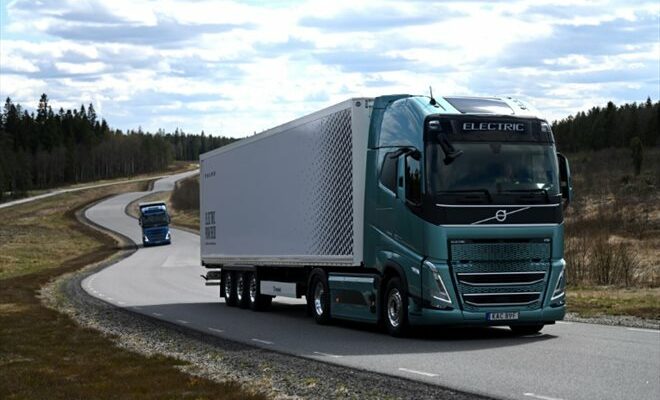A mega-truck (“gigaliner”) in 2013 in Germany in the state of Mecklenburg-Western Pomerania (dpa/AFP/Archives/Jens Büttner)
MEPs could approve on Tuesday the circulation in the EU of “mega-trucks” up to 25 meters and 60 tonnes: the rail freight sector is alarmed by the competition from these titans of the roads, in unison with elected officials denouncing their dangers for safety and the environment.
These extendable trucks, made up of a container plus a trailer, exist in a handful of countries (Sweden, Finland, the Netherlands, Germany, etc.), but this text, voted on in plenary session before negotiations with Member States, could boost their development.
The legislative revision aims first to encourage the growth of electric or hydrogen heavy goods vehicles, heavier and bulkier technologies, by raising the maximum weight of zero-emission trucks traveling between EU countries to 44 tonnes (compared to 40 currently). EU.
Diesel vehicles would also benefit from this increase to 44 tonnes until 2034, and could even weigh more if the States between which they circulate allow it for “intermodal” freight operations (combination of train/boat and road).
Above all, the circulation of “mega-trucks” (up to 60 tonnes according to European standards) would be automatically authorized between consenting neighboring states, on the basis of their national regulations.
The stated interest: save fuel consumption and carbon emissions by transporting more in fewer journeys.
A text validated in mid-February by the parliamentary Transport committee in the name of greening freight. “We propose to rationalize the use of mega-trucks with an assessment of the impact on safety, infrastructure, the environment” and “a European label”, assured its rapporteur, the socialist MEP Isabel Garcia Munoz.
-“Clogged roads”-

A Volvo electric truck (front) and a Volvo fuel cell truck (behind) drive at the company’s testing ground in Hällered, east of Gothenburg, Sweden, May 4, 2023. (AFP/ Sergei GAPON)
For rail players, this increased competitiveness of road transport will inevitably weaken their development.
“We are firmly opposed to the increase in weight and size of non-electric trucks, to the cross-border flows of mega-trucks (…) which would circulate unhindered from Poland to Spain,” says Sigrid Nikutta, boss of DB Cargo, rail freight giant.
“This will clog up our already congested roads, put pressure on bridges… The impact will wipe out environmental gains, by encouraging road use even when rail is more efficient and ecological,” she complained to the press.
According to Brussels, this text alone would help reduce CO2 emissions from freight transport by around 1.2% over 2025-2050, and would save transporters 45 billion euros over this period, thanks to harmonized standards and additional volume transported per journey.
But according to the German firm D-Fine, the legislation could divert up to 21% of rail freight to road transport, leading to up to 10.5 million additional truck journeys per year, or 6.6 million tonnes of CO2 emitted in addition. He also points out the technically complicated transfer between mega-trucks and trains.
The European objective of doubling the share of rail in freight transport by 2030, to 30%, “will be jeopardized”, says Alberto Mazzola, director of the European Rail Community (CER), an influential sector lobby .
-“Madness”-
“Rail is seven times more energy efficient than road,” sighs Frédéric Delorme, president of Rail Logistics Europe (SNCF), also denouncing “the significant dangers of mega-trucks for pedestrians and cyclists”: extended braking distance, difficulties to turn…
In Brussels, it is objected that they “are generally only authorized on certain major routes” outside cities, with mandatory braking technologies, stability control, cameras, etc.
There remains the impact of heavy trucks on roads and bridges: D-Fine predicts 1.15 billion euros in additional public spending per year for the maintenance of road infrastructure, with “disproportionate deterioration: ten 44-ton trucks make more damage than fifteen of 40 tons”.
Rail players wish to reserve mega-trucks for specific situations where no rail alternative exists, and to restrict the “road” segments of intermodal transport.
Their concerns are relayed by around sixty MEPs – Greens and French elected officials from all sides – who co-signed amendments to remove the provisions on “mega-trucks”.
“We must prevent this madness, with too few resources for rail freight while a bonus would be allocated to +mega-trucks+ destroying infrastructure,” insists environmentalist MEP David Cormand.
In the Transport Committee, the text was however massively supported by the social democratic, PPE (right) and Renew (liberal) groups, with the exception of Frenchman Dominique Riquet. The file reflecting national sensitivities, “the balance will be precarious” in plenary, recognizes his colleague Marie-Pierre Vedrenne.
© 2024 AFP
Did you like this article ? Share it with your friends using the buttons below.




